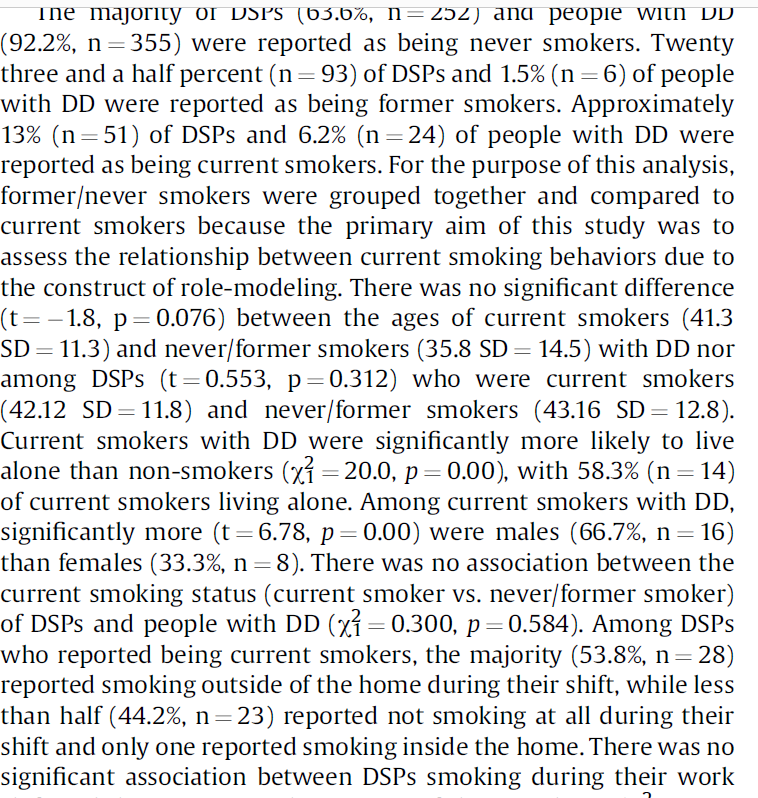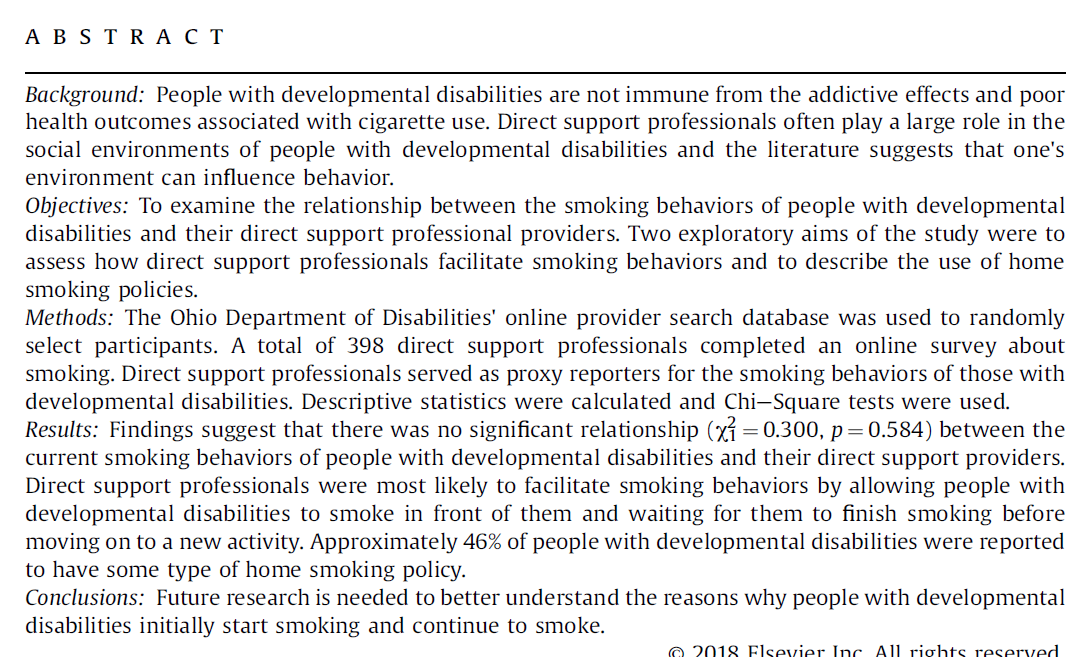How can the results from this study be appropriately applied to everyday life? Group of answer choices 1. Direct support professionals who smoke are not likely to influence the smoking behaviors of their clients with developmental disabilities 2. Direct support professionals who work with clients with developmental disabilities should be required to quit smoking 3. You should feel free to smoke around individuals with developmental disabilities because it will definitely not influence their smoking behaviors 4. You should never smoke around an individual with a developmental disability because they are more likely to adopt smoking behaviors
How can the results from this study be appropriately applied to everyday life? Group of answer choices 1. Direct support professionals who smoke are not likely to influence the smoking behaviors of their clients with developmental disabilities 2. Direct support professionals who work with clients with developmental disabilities should be required to quit smoking 3. You should feel free to smoke around individuals with developmental disabilities because it will definitely not influence their smoking behaviors 4. You should never smoke around an individual with a developmental disability because they are more likely to adopt smoking behaviors
Ciccarelli: Psychology_5 (5th Edition)
5th Edition
ISBN:9780134477961
Author:Saundra K. Ciccarelli, J. Noland White
Publisher:Saundra K. Ciccarelli, J. Noland White
Chapter1: The Science Of Psychology
Section: Chapter Questions
Problem 1TY
Related questions
Question
How can the results from this study be appropriately applied to everyday life?
Group of answer choices
1. Direct support professionals who smoke are not likely to influence the smoking behaviors of their clients with developmental disabilities
2. Direct support professionals who work with clients with developmental disabilities should be required to quit smoking
3. You should feel free to smoke around individuals with developmental disabilities because it will definitely not influence their smoking behaviors
4. You should never smoke around an individual with a developmental disability because they are more likely to adopt smoking behaviors

Transcribed Image Text:The majority of DSPS (63.6%, n=252) and peopie with DD
(92.2%, n=355) were reported as being never smokers. Twenty
three and a half percent (n= 93) of DSPS and 1.5% (n=6) of people
with DD were reported as being former smokers. Approximately
13% (n=51) of DSPS and 6.2% (n=24) of people with DD were
reported as being current smokers. For the purpose of this analysis,
former/never smokers were grouped together and compared to
current smokers because the primary aim of this study was to
assess the relationship between current smoking behaviors due to
the construct of role-modeling. There was no significant difference
(t=–1.8, p=0.076) between the ages of current smokers (41.3
SD=11.3) and never/former smokers (35.8 SD= 14.5) with DD nor
among DSPS (t=0.553, p=0.312) who were current smokers
(42.12 SD=11.8) and never/former smokers (43.16 SD= 12.8).
Current smokers with DD were significantly more likely to live
alone than non-smokers (xỉ = 20.0, p = 0.00), with 58.3% (n =14)
of current smokers living alone. Among current smokers with DD,
significantly more (t=6.78, p=0.00) were males (66.7%, n=1
|
= 16)
than females (33.3%, n =8). There was no association between the
current smoking status (current smoker vs. never/former smoker)
of DSPS and people with DD (xi = 0.300, p=0.584). Among DSPS
who reported being current smokers, the majority (53.8%, n=
28)
reported smoking outside of the home during their shift, while less
than half (44.2%, n=23) reported not smoking at all during their
shift and only one reported smoking inside the home. There was no
significant association between DSPS smoking during their work

Transcribed Image Text:A B S TR A C T
Background: People with developmental disabilities are not immune from the addictive effects and poor
health outcomes associated with cigarette use. Direct support professionals often play a large role in the
social environments of people with developmental disabilities and the literature suggests that one's
environment can influence behavior.
Objectives: To examine the relationship between the smoking behaviors of people with developmental
disabilities and their direct support professional providers. Two exploratory aims of the study were to
assess how direct support professionals facilitate smoking behaviors and to describe the use of home
smoking policies.
Methods: The Ohio Department of Disabilities' online provider search database was used to randomly
select participants. A total of 398 direct support professionals completed an online survey about
smoking. Direct support professionals served as proxy reporters for the smoking behaviors of those with
developmental disabilities. Descriptive statistics were calculated and Chi–Square tests were used.
Results: Findings suggest that there was no significant relationship (xỉ = 0.300, p=0.584) between the
current smoking behaviors of people with developmental disabilities and their direct support providers.
Direct support professionals were most likely to facilitate smoking behaviors by allowing people with
developmental disabilities to smoke in front of them and waiting for them to finish smoking before
moving on to a new activity. Approximately 46% of people with developmental disabilities were reported
to have some type of home smoking policy.
Conclusions: Future research is needed to better understand the reasons why people with developmental
disabilities initially start smoking and continue to smoke.
O 2018 Flsevier Inc All rights reserved
Expert Solution
This question has been solved!
Explore an expertly crafted, step-by-step solution for a thorough understanding of key concepts.
Step by step
Solved in 5 steps

Recommended textbooks for you

Ciccarelli: Psychology_5 (5th Edition)
Psychology
ISBN:
9780134477961
Author:
Saundra K. Ciccarelli, J. Noland White
Publisher:
PEARSON

Cognitive Psychology
Psychology
ISBN:
9781337408271
Author:
Goldstein, E. Bruce.
Publisher:
Cengage Learning,

Introduction to Psychology: Gateways to Mind and …
Psychology
ISBN:
9781337565691
Author:
Dennis Coon, John O. Mitterer, Tanya S. Martini
Publisher:
Cengage Learning

Ciccarelli: Psychology_5 (5th Edition)
Psychology
ISBN:
9780134477961
Author:
Saundra K. Ciccarelli, J. Noland White
Publisher:
PEARSON

Cognitive Psychology
Psychology
ISBN:
9781337408271
Author:
Goldstein, E. Bruce.
Publisher:
Cengage Learning,

Introduction to Psychology: Gateways to Mind and …
Psychology
ISBN:
9781337565691
Author:
Dennis Coon, John O. Mitterer, Tanya S. Martini
Publisher:
Cengage Learning

Psychology in Your Life (Second Edition)
Psychology
ISBN:
9780393265156
Author:
Sarah Grison, Michael Gazzaniga
Publisher:
W. W. Norton & Company

Cognitive Psychology: Connecting Mind, Research a…
Psychology
ISBN:
9781285763880
Author:
E. Bruce Goldstein
Publisher:
Cengage Learning

Theories of Personality (MindTap Course List)
Psychology
ISBN:
9781305652958
Author:
Duane P. Schultz, Sydney Ellen Schultz
Publisher:
Cengage Learning